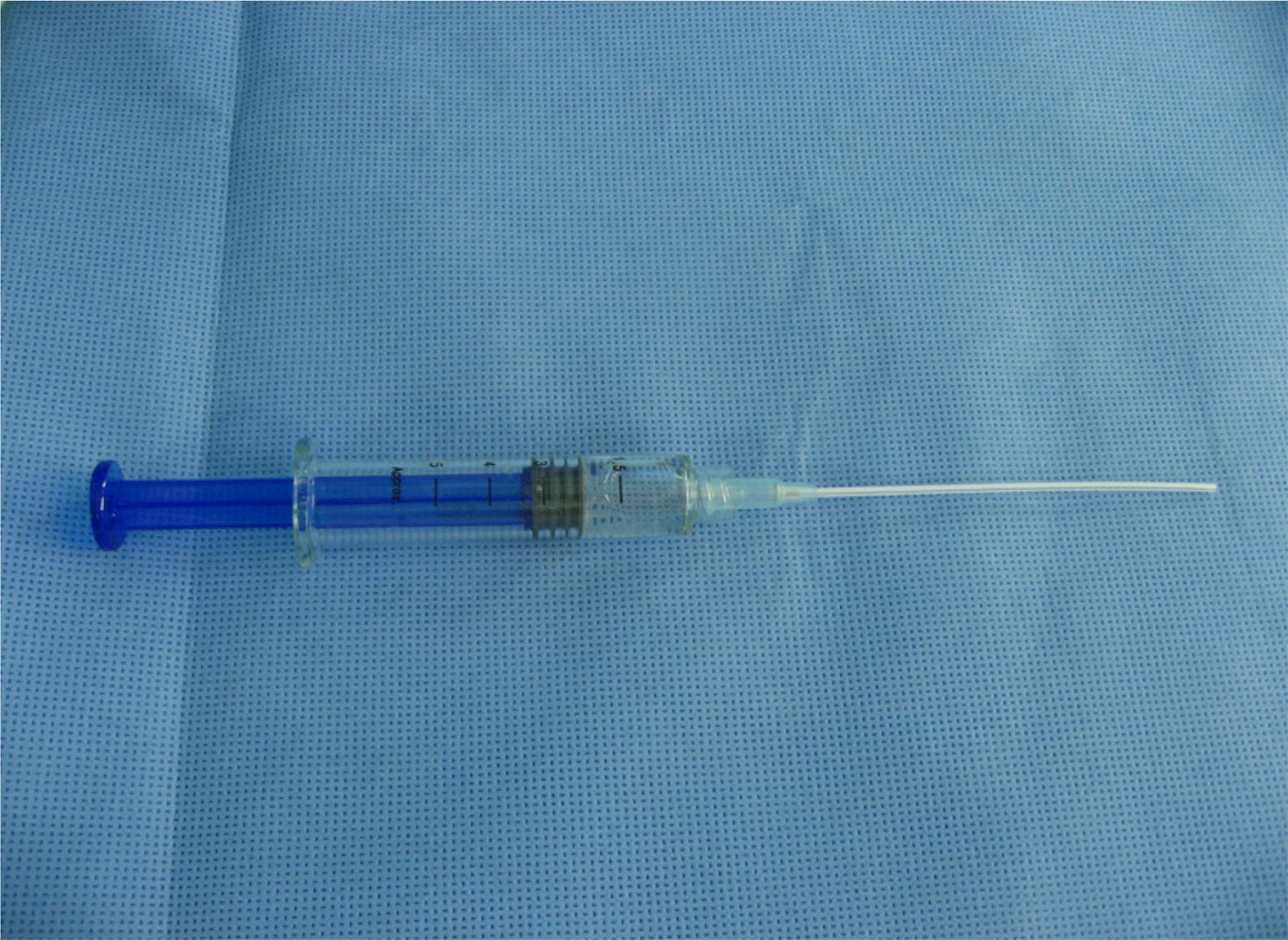Abstract
Purpose
To evaluate the long-term results of the application of a mixed solution of hyaluronate and sodium carboxymethlycellulose (HACMC, Guardix-sol) intraoperatively in endonasal dacryocystorhinostomy (Endo-DCR).
Methods
In this retrospective randomized controlled study, Endo-DCR and silicone tube intubation were performed on 83 eyes of 83 patients who were diagnosed with nasolacrimal duct obstruction. In group A (40 patients, 40 eyes), HACMC was applied to the osteotomy site in the nasal cavity after standard Endo DCR procedure. In group B (43 patients, 43 eyes), a standard Endo-DCR procedure was performed without HACMC. The results for the two groups were evaluated by asking patients about the tearing condition and examining the patency of irrigation, complications, and related treatment.
Results
There were no statistically significant differences in age, sex, silicone tube insertion duration, or mean follow-up time between the two groups. The primary success rates of the group A and the group B were 87.5% (35/40) and 81.4% (35/43), respectively. The final success rates after the revisonal surgery were 92.5% (37/40) and 86.0% (37/43), respectively, and there were no statistically significant differences between the two groups (P=0.348, Fisher's exact test).
Go to : 
References
1. Toti A. Nuovo metodo conservatore di cura radical delle suppor-azioni chronoche del sacco lacrimale. Clin Moderna. 1904; 10:385–9.
2. Zollin CL, Shannonn GM. Dacryocystorhinostomy: a review of 119 cases. Ophthalmic Surg. 1982; 13:905–10.
3. Burns JA, Cahill KV. Modified Kinosian dacryocystorhinostomy: a review of 119 cases. Ophthalmic Surg. 1985; 16:710–6.
4. Roozitalab MH, Amirahmadi M, Namazi MR. Results of the application of intraoperative mitomycin C in dacryocystorhinostomy. Eur J Ophthalmol. 2004; 14:461–3.

5. Kong YT, Kim TI, Kong BW. A report of 131 cases of endoscopic laser lacrimal surgery. Ophthalmology. 1994; 101:1793–800.

6. Leone CR. Gelfoam-thrombin dacryocystorhonostomy. Am J Ophthalmol. 1982; 94:412–3.
7. Rosen N, Sharir M, Moverman DC. Dacryocystorhinostomy with silicone tubes evaluation of 253 cases. Ophthalmic Surg. 1989; 20:115–9.

8. Park DJ, Kwak MS. The effect of mitomycin C on the success rate of endoscopic dacryocystorhinostomy. J Korean Ophthalmol Soc. 2000; 41:1674–9.
9. Kim KS, Yoon HC, Lee JH, et al. Antiadhesive effect of guardix-sl after endoscopic sinus surgery. Korean J Otolaryngol. 2005; 48:1478–83.
10. Kwon SW, Seo YW, Cho YA. Antiadhesive effect of the mixed solution of hyaluronate and sodium carboxymethylcellulose after strabismus surgery. J Korean Ophthalmol Soc. 2009; 50:145–50.

11. Frenkiel S, Desrosiers MY, Nachtigal D. Use of hylan B gel as a wound dressing after endoscopic sinus surgery. J Otolaryngol. 2002; 31:41–4.

12. Lee JM, Lee YJ, Kim JH. The effect of Mitomycin C aberrations in Endonasal Dacryocystorhinostomy. J Korean Ophthalmol Soc. 2004; 45:1609–14.
13. Caldwell GW. Two new operations for obstruction of the nasal duct with preservation of the canaliculi and an incidental description of a new lacrimal probe. Am J Ophthalmol. 1893; 10:189.
14. Boush GA, Lemke BN, Dorzbach RK. Results of endonasal laser-assisted dacrycystorhinos tomy. Ophthalmology. 1994; 101:955–9.
15. Lee HC, Chung WS. Success rate of endonasal aberrations. J Korean Ophthalmol Soc. 1996; 37:211–8.
16. Kao SC, Liao CL, Tseng JH, et al. Dacryocystorhinostomy with intraoperative mitomycin C. Ophthalmology. 1997; 104:86–91.

17. Yeatts RP, Neves RB. Use of mitomycin-C in repeat aberrations. Ophththalmic Plast Reconstruct Surg. 1999; 15:19–22.
18. Zilelioglu G, Ugurbas SH, Anadolu Y, et al. Adjunctive use of mitomycin C on endoscopic lacrimal surgery. Br J Ophthalmol. 1998; 82:63–6.
19. Kimmelman CP, Edelstein DR, Cheng HJ. Sepragel sinus(hylan B) as a postsurgical dressing for endoscopic sinus surgery. Otolaryngol Head Neck Surg. 2001; 125:603–8.
20. Bar A, Van Ommen B, Timonen M. Metabolic disposition in rats of regular and enzymatically depolymerized sodium aberrations. Food Chem Toxicol. 1995; 33:901–7.
21. Lindberg JV, Anderson RL, Bumsted RM, Barretas R. Study of intranasal ostium external dacryocystorhinostomy. Arch aberrations. 1982; 100:1758–62.
Go to : 
 | Figure 1.0.25% sodium hyaluronate + 0.49% carboxymethylcellulose (Gardix-sol, Hanmi MediCare, Korea). |
Table 1.
Demographic data of patients
Table 2.
Preoperative diagnosis in two groups
| |
Number of cases (%) |
|
|---|---|---|
| Group A (n=40) | Group B (n=43) | |
| Nasolacrimal duct obstruction | 22(55.5%) | 25(58.1%) |
| Chronic dacryocystitis | 16(40.0%) | 17(39.5%) |
| Previous failed DCR* | 2(5.0%) | 1(2.3%) |
Table 3.
Total success rate of DCR
| |
Number of case (%) |
|
|---|---|---|
| Group A (n=40) | Group B (n=43) | |
| Primary Success* Rate | 87.5%(35/40) | 81.4%(35/43) |
| Final Success Rate | 92.5%(37/40) | 86.0%(37/43) |




 PDF
PDF ePub
ePub Citation
Citation Print
Print


 XML Download
XML Download